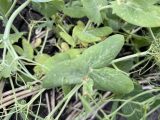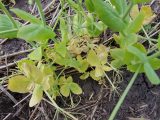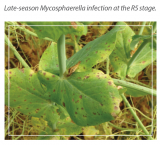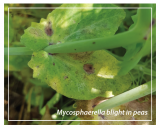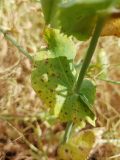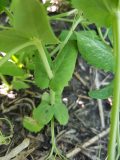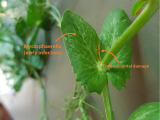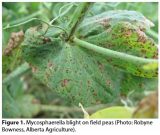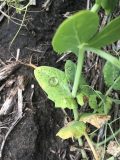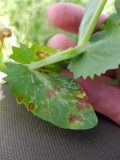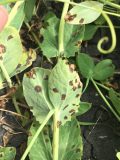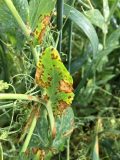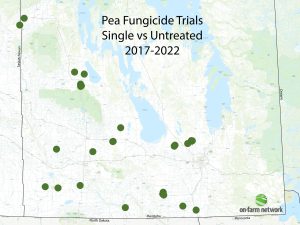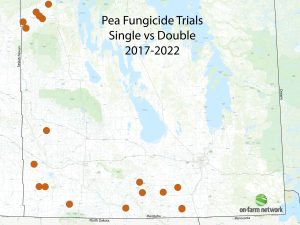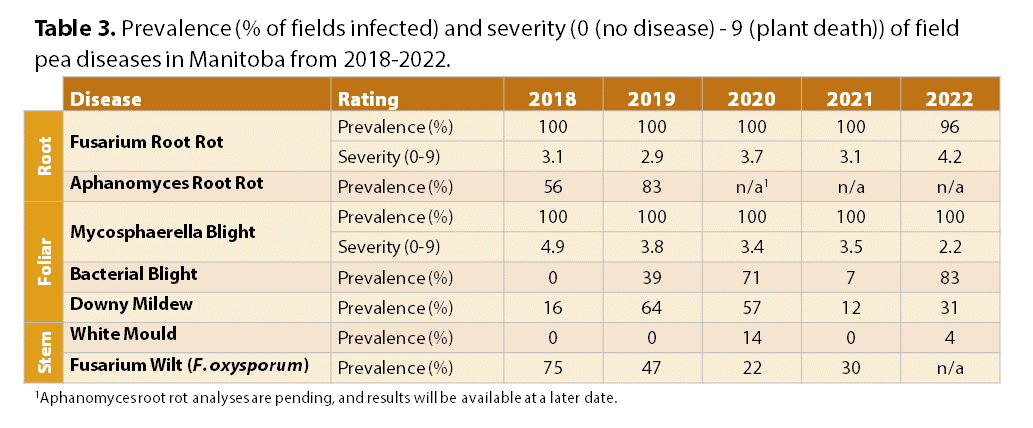Managing Mycosphaerella (Ascochyta) Blight
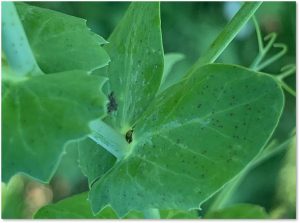 The main disease managed by foliar fungicides in peas is mycosphaerella (ascochyta) blight (pictured right). Fungicides also offer control or suppression of white mould, downy mildew, grey mould and rust, depending on the product. However, these diseases are less frequent and less severe in Manitoba-grown peas. Scout for mycosphaerella symptoms from V10 (10th true node) to R2 (beginning bloom), during mid-June to late July.
The main disease managed by foliar fungicides in peas is mycosphaerella (ascochyta) blight (pictured right). Fungicides also offer control or suppression of white mould, downy mildew, grey mould and rust, depending on the product. However, these diseases are less frequent and less severe in Manitoba-grown peas. Scout for mycosphaerella symptoms from V10 (10th true node) to R2 (beginning bloom), during mid-June to late July.
Foliar fungicide application for control of mycosphaerella blight should be made at early flower (R2), when one flower is open on most plants across the field.  The goal is to get good fungicide coverage on leaves in the lower canopy. This means spraying just before the canopy begins to close. However, in drier years, it may be beneficial to delay application. There is a fungicide decision worksheet available to determine if a fungicide application is likely to be beneficial and timely.
The goal is to get good fungicide coverage on leaves in the lower canopy. This means spraying just before the canopy begins to close. However, in drier years, it may be beneficial to delay application. There is a fungicide decision worksheet available to determine if a fungicide application is likely to be beneficial and timely.
If a score is below 65, or above 65 but disease is not yet present, revisit the field in a few days and reassess. If the field is scoring above 65 but disease is not present, conditions are suitable for disease to develop and the field should be revisited in a few days to catch any developing symptoms early.
Continue to monitor for Mycosphaerella and its progression up the pea canopy from early bloom (R2) to full pod (R4) to determine if a second application may be warranted. If symptoms spread into the mid to upper canopy and warm, humid weather persists, consider a second fungicide application 10-14 days later using a different mode-of-action.
To aid the decision of whether or not to apply fungicide, follow this decision worksheet to determine your risk level of mycosphaerella blight development.
Symptoms of Mycosphaerella Blight vs. Bacterial Blight
Mycosphaerella blight and bacterial blight symptoms are commonly confused. Bacterial blight will not be managed by a fungicide so accurate identification is key.
Mycosphaerella blight:
- Early lesions appear as small purple-brown freckles or as large circular, ringed lesions.
- Initial infection typically begins in the lower canopy on the bottom-most leaves and move up the plant as infection progresses.
Bacterial blight:
- Lesions are broken by leaf veins, resulting in an angular appearance.
- Initially, lesions have water-soaked edges. As infection progresses, lesions have a window-pane appearance.
- Most often, occurs in the mid or upper canopy that was exposed during storms. Wounds from high winds, storms or mechanical damage are sites where bacterial blight colonizes.
- May infect leaves, stems and pods.
On-Farm Network Fungicide Research Results
Since 2017, 41 randomized and replicated, field-scale trials have been conducted across Manitoba to evaluate foliar fungicide in peas. Of those 41 trials, 25 have compared a single application of fungicide at flowering vs. no fungicide and 16 have compared double vs. single applications.
In addition to yield response, incidence (percent of plants infected) and severity of mycosphaerella blight and white mould were evaluated.
A single foliar fungicide application applied at flowering improved pea yield 28% of the time, increasing yield by 4.6 bu/ac on average. A second application of fungicide applied 10 to 14 days later improved pea yield 44% of the time, resulting in a yield increase of 5.1 bu/ac on average.
View results from individual On-Farm Network pea fungicide trials here.
Pea yield response to fungicide varies among farms and will only be economical if the disease pressure is there, or if conditions are conducive for disease development. Use the Fungicide Decision Worksheet for Managing Mycosphaerella Blight in Field Peas to help you decide if a fungicide application will be beneficial in your field.
Small-Plot Fungicide Research Results
A small-plot study testing various pea inputs was conducted at Minto and Hamiota in 2015 and 2016. These trials tested no fungicide vs. one application (Headline EC at 10% flower) vs. two applications (Headline EC at 10% flower + Priaxor 12-13 days later).
In 2015, there was a significant effect of fungicide application compared to no fungicide. However, there was no difference between one application and two applications of fungicide (Table 1). At Hamiota (2016), there was a significant yield response to two applications of fungicide and no response to one application of fungicide. At Minto (2016), there was a significant yield response to both one and two applications of fungicide. Two applications of fungicide resulted in the highest yield; however, the overall yield potential was low at this site.
Table 1. Field pea yield response in small-plot trials across Manitoba from 2015-2016.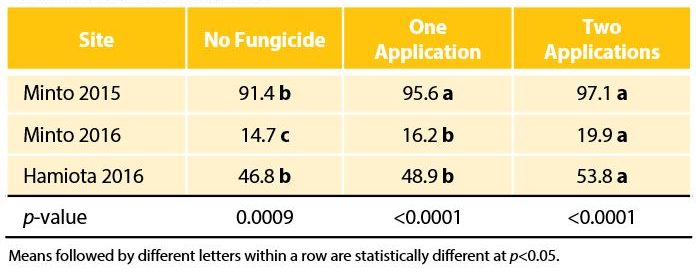
Foliar Disease Survey Results
Annually, pea fields are surveyed for foliar diseases during mid- to late-July at the R3 to R4 stages (flat pod to full pod). Diseases evaluated include mycosphaerella blight, bacterial blight, downy mildew, white mould, powdery mildew, anthracnose, rust and septoria leaf blotch.
Mycosphaerella blight is the most common foliar disease and is typically found in every pea field, every year. Severity of mycosphaerella has been low to moderate, with disease lesions restricted to the lower canopy of most fields.
Additional Resources
Fungicide Decision Worksheet for Managing Mycosphaerella (Ascochyta) Blight in Field Peas
The Pea Report: All Things Ascochyta – Pulse Beat June 2021
Managing Ascochyta Blight in Field Peas – Pulse Beat June 2019
The Effects of Seeding Rate and Fungicide Application on Field Peas in Manitoba – Manitoba Agronomists Conference Poster
Fungicide Decision Support Checklist for Ascochyta & Mycosphaerella Blight in Pea – Saskatchewan Pulse Growers

